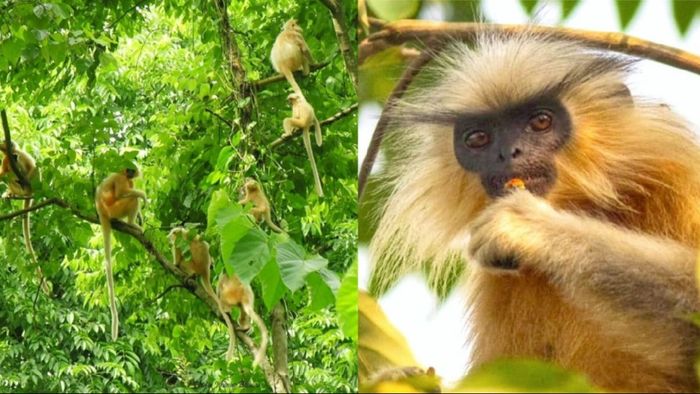Comprehensive population estimation reveals 7396 individuals of Golden Langur in India
A comprehensive population estimation of the endangered golden langur (Trachypithecus geei), the sole representative of the mythological character Sugriva in RAMAYANA was conducted in its entire distribution range in India, covering the Manas Biosphere Reserve and all fragmented forests of its southern distribution range in north-western Assam.

- Mar 10, 2024,
- Updated Mar 10, 2024, 8:51 AM IST
A comprehensive population estimation of the endangered golden langur (Trachypithecus geei), the sole representative of the mythological character Sugriva in RAMAYANA was conducted in its entire distribution range in India, covering the Manas Biosphere Reserve and all fragmented forests of its southern distribution range in north-western Assam.
The survey was jointly conducted by the Primate Research Centre NE India (PRCNE), Forest Department, Bodoland Territorial Council, SACON and Conservation Himalayas in two phases.
In the first phase, the survey covered the western part of the Manas Biosphere Reserve, including Ripu Reserved Forest (recently major part of which upgraded to Raimona National Park), Chirang RF, Manas RF, and Manas NP up to the western bank of the river Manas.
The second phase focused on fragmented forest habitats of golden langurs in Bongaigaon, Kokrajhar, and Dhubri districts of Assam.
The survey applied the occupancy framework of the block count method to assess the abundance, spatial distribution, and densities of golden langurs. This method is applied for the first time for golden langur, which is considered to be relatively simple, cost-effective, and robust, especially for arboreal, small group-living primates like the golden langur said Dr. HN Kumara, Principal Scientist of SACON.
"We selected the survey area by carefully considering the suitable habitat of the golden langur in India. Subsequently, a base map was prepared for each RF/PRF/PA and broadly demarcated into a 51 counting blocks based on the identified suitable habitat, each overlaid with 50 hectare grids cells.
These counting blocks were then surveyed by ten enumeration teams, with one team assigned to each counting unit. Altogether, there were 10 teams, each comprising one or two trained enumerators and 3-4 forest staff. These teams diligently conducted surveys within their assigned areas over a total period of 56 days," said the lead primatologist Dr. Jihosuo Biswas of PRC NE under whose supervision the survey was conducted.
"We observed 7,720 individuals of golden langurs in 706 unique groups and 31 lone males or floating males. Estimating a minimum population size, we found there to be 7,396 individuals in 707 groups, inclusive of bisexual and male bands, along with 31 lone males".
"The population of golden langurs is divided into two major sub-populations: (a) the 'northern extended population,' which encompasses the western part of the Manas Biosphere Reserve, extending from the Sankosh to the Manas River up to the Indo-Bhutan border along the northern side of the national highway (NH 27) and state highway (SH 2), and (b) the 'southern fragmented population,' which occurs along the southern side of the national highway (NH 27) up to the river Brahmaputra in the south," explained Dr. Biswas.
The northern population of Golden langurs in Manas Biosphere Reserve is estimated to be 5566 langurs in 534 groups (bisexual and all-male bands) and 23 lone males, while the population of Golden langurs in southern fragments is estimated to be 1830 langurs in 173 groups (bisexual and all-male bands) and 8 lone males.
"The major population of golden langurs in the Manas Biosphere Reserve was found in Ripu RF, with 2,847 individuals, a part of which has recently been upgraded to Raimona NP covering an area of 422 sq. km. This was followed by Chirang RF, with 2,000 individuals, and Manas NP, with 719 individuals.
Similarly, in the southern fragments, the major populations were found in Chakrashila WLS of Kokrajhar district, with 838 individuals, and Kakoijana RF of Bongaigaon district, with 464 individuals, which was recently proposed as a WLS for golden langur conservation," revealed Dr. Biswas.
Compared to the previous population estimation conducted in 2008-09 under the supervision of Dr. Biswas, which estimated 6,000 individuals of golden langurs in India, the current estimation revealed an increasing population trend. However, satellite imagery shows shrinkage of forest cover which negatively impacts their habitats.
Additionally, the group size was found to be larger, with an average of 10.69 individuals per group, ranging from 2 to 30 individuals, compared to 9.24 individuals per group in the previous population estimation.
However, the demographic analysis indicates an unstable situation in fragmented habitats, particularly due to the absence of non-breeding all-male bands in fragmented populations. Dr. Joydeep Shil of SACON, who also took part in the survey, expressed concerns about these unstable populations. He highlighted the potential for demographic bottlenecks and questioned their long-term viability.
"Despite regular infant recruitment, the percentages of juveniles and immature individuals compared to adults were invariably low in all other fragmented habitats," noted Dr. Biswas. "The low percentage of infants compared to juveniles and adults entails that these populations have a higher rate of mortality in the immature stage, which might be due to some human-induced factors such as road accidents, feral dog attacks, electrocution, or exposure to parasites etc."
Dr. Biswas echoed concerns about these fragmented populations, highlighting the potential threats they face from various anthropogenic interactions. Dr. Biswas also highlighted the need of corridor linkage among the fragmented habitats through plantations and canopy bridges.
Based on this study, stated Dr. Biswas, "we conducted a strategic planning workshop to develop a Conservation Action Plan for the Golden langur in India, involving multiple stakeholders. A draft Action Plan has already been prepared and is currently under review for finalization."
Fortunately, in late February 2024, the BTC government announced the upgrading of Chirang RF into two protected areas, namely Chiknajhar NP and Upendra Nath Brahma WLS. Once upgraded, almost 90% of the golden langur habitat in India would come under the protected area network. This move is expected to provide enhanced protection and conservation measures for the golden langur population and their habitat.